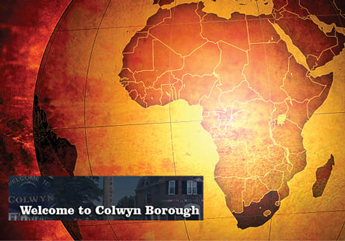In southwest Philly, a ‘little Africa’ is growing
By AP | Last updated: Jan 1, 2014 - 3:07:54 PMWhat's your opinion on this article?

|
Shelves are loaded with beauty products from his native Ivory Coast. Bins hold plantain flour and baobab fruit from Mali. A flat-screen TV features Nigerian soap operas. In back, a Muslim woman kneels in prayer. Up front, customers banter in French, Mandinka, and English.
With census data released showing a 239 percent increase since 2000 in the region’s African immigrant population; Mr. Bakayoko’s strip of Woodland Avenue near 65th Street is a growing “little Africa” that lures shoppers from the city and nearby suburbs.
Across the avenue from Bakayoko & Son is African Small Pot, “original food from the Motherland.”
Hatim Barria, of Folcroft, Delaware County, enjoys the district.
“I get a variety of things (at the grocery), African ingredients, telephone cards,” he said.
Mr. Barria, 54, a cabdriver, was born in Sierra Leone. He came to the United States in 2001 for a better life, he said, and now most of his family is here.
Between 2000 and 2012, according to the decennial census and annual snapshots by the Census Bureau, the estimated African population tripled in Southwest Philadelphia and nearly quadrupled in southeastern Delaware County.
Across that same swath and time, the number of Africans grew from about 3,000 to more than 10,000; their share of the total population, from 3 percent to 11 percent.
Many are from Ghana, Ethiopia, Liberia, Nigeria, and Sierra Leone.
Liberians, such as Khalifa Donzo, 42, make up a third of the region’s African immigrants.
Early Dec. 20, Mr. Donzo, a soccer fan, was alone doing calisthenics on a lot near Lindbergh Boulevard and 63d Street.
He said many Liberians came to America a decade or more ago as refugees displaced by civil war. Later, they petitioned to have relatives join them. As a member of the Mandinka ethnic group, which was persecuted by government soldiers during the war, he said, he qualified for asylum in America in 1999. He arrived in New York but had a friend in Philadelphia and moved here within the year. He is married to a Liberian woman. They have three U.S.-born children.
The southeastern Delaware County borough of Colwyn, population about 2,500, had a huge surge in African immigrants — from about 75 in 2000 to about 500 now.
Most are Liberian, Nigerian, and Sierra Leonean, and they were attracted to Colwyn by its two-story brick row houses that sell for less than $100,000, and the plentiful public transportation.
Voffee Jabateh, who was born in Liberia, directs the African Cultural Alliance of North America, a community development group with an office on Chester Avenue near 55th Street.
“People are comfortable where they have a support system,’ he said. ‘In this case, the 1990s migration into the area by people who were uprooted by the civil war’ paved the way. ‘If you were in America for the first time and your cousin lives in this area, wouldn’t you want to come to the place where your cousin is here to receive you?
“Southwest Philadelphia, Colwyn, Darby, Upper Darby. We live here almost as we lived in Monrovia, surrounded by all our friends who followed us into the diaspora.”
Despite some resentments among longtime residents, the newcomers have also been well received.
“Where I live (on Second Street in Colwyn), it is all African now,said Theresa Snell, who is White. “My neighbor is Liberian and nice as hell.”
After more than 20 years in the United States, Mr. Bakayoko, the grocer, got his green card this year.
Now 45, he said when he came to America from the Ivory Coast in 1992, most immigrants intended to stay a few years, make some money, and go back home.
“Before, people didn’t want to bring their wives and children,” he said. “But after 10 years, with nothing in your pocket” — no big financial score — and inertia setting in, he said, they miss their families and want to bring them.
They miss products and foods from home, too, he said, so he imports them.
He estimates about 50 percent of his clientele is from outside the city, with some customers from Delaware and New Jersey. (AP)
INSIDE STORIES AND REVIEWS
-
-
About Harriett ... and the Negro Hollywood Road Show
By Rabiah Muhammad, Guest Columnist » Full Story -
Skepticism greets Jay-Z, NFL talk of inspiring change
By Bryan 18X Crawford and Richard B. Muhammad The Final Call Newspaper @TheFinalCall » Full Story -
The painful problem of Black girls and suicide
By Charlene Muhammad -National Correspondent- » Full Story -
Exploitation of Innocence - Report: Perceptions, policies hurting Black girls
By Charlene Muhammad -National Correspondent- » Full Story -
Big Ballin: Big ideas fuel a father’s Big Baller Brand and brash business sense
By Bryan Crawford -Contributing Writer- » Full Story






 Click Here Stay Connected!
Click Here Stay Connected!








